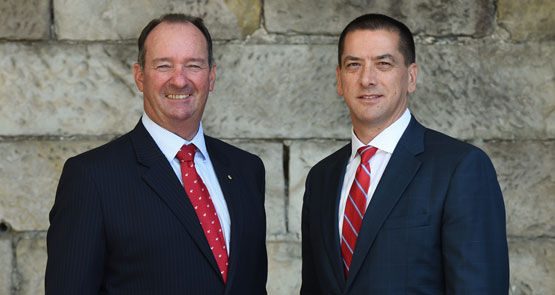
Whitehaven Chairman Mark Vaile (left) and CEO Paul Flynn (right)
There aren’t too many former politicians who make the transition to the Directors’ Club and generate good returns for investors. As Warren Truss contemplates his exit, one of his predecessors as National Party leader and deputy prime minister, Mark Vaile, has been seriously exposed by the commodities crunch. Not that he’s admitting there are problems out there for cratering coal companies like the one he chairs.
As Crikey noted when Jeff Kennett joined the Seven West Media board last year, the former Victorian premier has been associated with plenty of losing investments.
Similarly, former federal children’s minister Larry Anthony was a director of ABC Learning when it collapsed, pocketing undisclosed director fees along the way, Andrew Peacock chaired MFS, Bradken was in poor shape when long-serving chair Nick Greiner departed in 2015, and Shane Stone was on the board of City Pacific, another Gold Coast financial and property play, which collapsed after the GFC.
Mark Vaile has chaired Whitehaven Coal for the past four years after being introduced to the industry by Nathan Tinkler, who persuaded Vaile to chair his Aston Resources through a listing process in 2009-10.
Whitehaven has an interesting history. It was founded in 1999, floated in 2007 and then pulled off a three-way merger with Tinkler’s Aston Resources and Boardwalk Resources in 2012, after which Vaile emerge as the wealthy chairman of a company capitalised at $6 billion. In 2012, his 2.78 million shares peaked at about $14 million when the stock briefly traded above $6.
To his credit, Vaile largely retained his stake as the share price tanked, but with the stock tumbling 3.5 cents on Friday to 41 cents after a disappointing $7.8 million half-year net profit there are serious questions about his apparent optimism about Whitehaven and the coal industry more broadly.
In August 2015, with former Ernst & Young partner Trent van Veen in place as signing auditor for the last time, Whitehaven announced a $483 million annual loss after booking write-downs and one-off expenses of $447 million.
However, this only reduced the claimed net assets to $2.86 billion, when Whitehaven’s market capitalisation had plunged to around $1 billion.
It would have been an interesting meeting last month between new auditor Ryan Fisk, another partner at Ernst & Young, and the three-man Whitehaven audit committee comprising Mark Vaile, former BHP director John Conde and Rick Gazzard.
As Crikey’s Glenn Dyer noted in Friday’s “Business bites”, the write-offs have been coming thick and fast in the energy sector in recent weeks.
So why should Whitehaven declare no impairments on Friday, especially given its tumbling market capitalisation?
In my opinion, it should have taken a write-down of at least $1 billion. The prices achieved by Rio Tinto in its recent sell-down of NSW coal assets just don’t justify Whitehaven’s bullish outlook.
Whitehaven has a controversial history, and its chief banker, the David Gonski-chaired ANZ, has been specifically targeted for its exposures to exactly these sorts of carbon intensive mining companies.
Remember when activist Jonathan Moylan put out a fake ANZ press release in January 2013 as part of his campaign to stop Whitehaven’s $740 million Maules Creek coal mine? At the time, Whitehaven reaffirmed that ANZ was leading a $1.2 billion loan facility to the company, which is due to be repaid in 2019.
ANZ then came in for some specific attention at its 2014 AGM because it remains Australia’s biggest financier of carbon polluters. The Australasian Centre for Corporate Responsibility (ACCR) proposed a constitutional amendment pushing for greater carbon financing disclosure and it is worth reading the opening passage of the ACCR statement distributed to ANZ’s shareholders:
“Currently, in aggregate, fossil fuel companies are estimating with 90% certainty that they will be able to extract freely (for subsequent sale and combustion) over three times more carbon than is compatible with the internationally agreed ceiling. This inconsistency between financial accounting, physical reality and political intent is referred to as the ‘unburnable carbon bubble’. It is akin to a traditional speculative bubble because all investor’s expectations cannot be met. As the bubble bursts it is likely reserves and other fossil fuel specific assets will become stranded ie written down in value prior to the end of their economic life.”
Rather than so fiercely rebutting the ACCR position, in hindsight it would have been much better for both ANZ and Whitehaven if the $740 million Maules Creek mine had not been built.
As The Australian Financial Rewview reported on Friday, there are now analysts predicting that Whitehaven will struggle to repay its existing $925 million debt. It hasn’t paid a dividend since 2012.
Yet what did the company boast on the opening page of its Friday’s earnings release? “Gearing down slightly to 24%”.
This sounds very comfortable, but only because Mark Vaile is claiming Whitehaven can repay its $925 million debt and still be left with assets worth $2.88 billion when coal prices have crashed and the industry’s days look numbered.
The $2.88 billion net assets claim appears on page 4 of these audited accounts released on Friday. The current market valuation is barely $400 million.
Compare Whitehaven’s failure to take even the most modest of write-downs with this list of balance sheet impairments so far this reporting season:
- AGL: $795 million
- Beach Energy: up to $650 million
- BHP Billiton: US$7.2 billion
- South32: US$1.7 billion
- Woodside Petroleum: up to US$1.2 billion
Vaile might be miserable that his $14 million stake in Whitehaven Coal has crashed to be worth barely $1 million but his apparent blind faith in old king coal seems very difficult to justify.
The really surprising aspect is that the likes of Ernst & Young and ANZ are continuing to play along with the claim that everything is just fine because Whitehaven Coal has net tangible assets of $2.78 per share.
Whitehaven shares slipped further to a low of 40c this morning, suggesting this particular carbon bubble has well and truly burst, even if the suits remain in denial.
* An earlier version of this article misstated the worth of Vaile’s stake as $100,000. It is $1 million.








Crikey often gets stuck into miners who sell carbon for later emission. Considering that most of their customers for coal and gas would settle for energy without the carbon, global agreements need only require them to convert to selling non-carbon power. It would be more virtuous for Crikey to extol the desirability of Oz expanding its involvement in the extraction and processing of nuclear fuel for global industry.
Roger, as long as there are subscribers such as you around Crikey’s capitalist empire remains safe. When the cheap fossil fuels and other non-renewable resources become sufficiently depleted will be when you and your ilk might change; but that will be too late, won’t it.
Roger…why don’t you give it a rest?
Nuclear ‘anything’ is never going to happen in this country…fullstop!
I wonder how much government policy on non-renewables is just built around the idea that they don’t want to be the ones who are around when the fossil fuel industry starts announcing bankruptcies?
Very interesting paragraph from ACCR.
What sort of outcry will there be when the coal miners start demanding even more subsidies else they’ll shed jobs?
And what about when it is that fine corporate citizen, Adani?